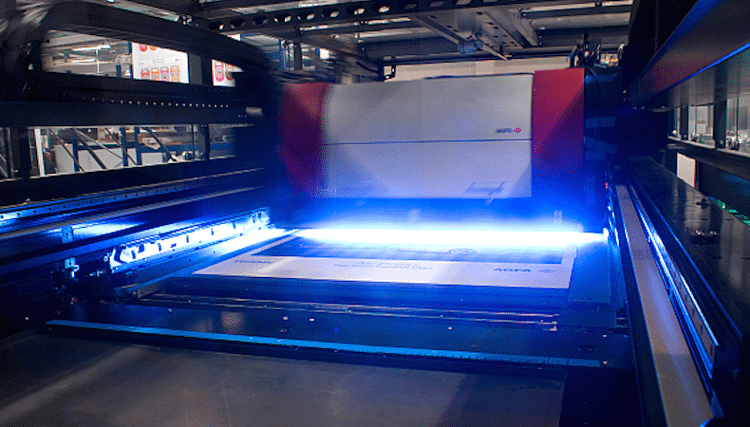EFI leads the LED fever

Not a week goes by that we don’t hear of another digital printer manufacturer making the switch to LED curing technology for ultra-violet (UV) inks.
In the digital printing arena, this is most commonly for wide format digital print engines. UV-curable inks stick to pretty much any nonabsorbent substrate including paper and board, wood, PVC, glass, metals and ceramics. They produce minimal VOCs so they don’t need expensive exhaust systems.
The arguments in favour of using LEDs instead of conventional mercury arc curing systems for UV ink curing get more compelling as technology advances and as more developers follow EFI’s lead and go for the LED alternative.
In part the rise of LED curing technologies is due to the market’s acceptance of UV-curable inks. Unlike conventional inks, UV inks do not dry through evaporation, but rather must be changed into a solid surface that sits on top of the substrate. A UV light source heats the printed inks, which contain photoinitiators and other ingredients.
The heat causes photoplymers in the ink to cross link and form a solid layer. The ink sits on the substrate surface rather than being partially absorbed into it, so these inks can have much larger and more intense colour gamuts than conventional offset inks.
They are also instantly dry so the prints can move straight into finishing, storage or be readied for shipping. This can hit the bottom line, in that it means faster throughput in the plant and ultimately more jobs on press.
And LEDs are cheaper than mercury bulbs, lasting for several years instead of two or three which is the case with the mercury lamps. LEDs are far kinder to fragile substrates than mercury arc lamps, they use less energy, don’t have to warm up before they start working and they can be switched off when there is no curing to be done.
They also pose no risk if they fail, unlike mercury arc lamps which involve glass and mercury and lots of heat. The thing mercury arc lamps have going for them is their sheer intensity and power, which means curing takes place very, very quickly.
For high productivity environments where absolute top notch quality output must be produced at speed, mercury arc curing is still the preferred choice for some manufacturers, such as Inca. However, it’s just a matter of time before LED technology advances such that it makes sense for all manufacturers make the switch.
Source: This article was produced by the Verdigris project, an industry initiative intended to raise awareness of print’s positive environmental impact. This commentary helps printing companies keep up to date with environmental standards, and how environmentally friendly business management can help improve their bottom lines. Verdigris is supported by the following companies: Agfa Graphics, Spindrift.click, EFI, FESPA, HP, Kodak, Kornit Digital, Ricoh, Splash PR, Unity Publishing and Xeikon.
Topics
Interested in joining our community?
Enquire today about joining your local FESPA Association or FESPA Direct
Recent news

Streamlining personalisation with tech: Insights from the SmartHub Conference 2025 speakers
Personalisation Experience 2025 (6 – 9 May 2025, Messe Berlin, Germany) is running its inaugural SmartHub Conference from 6 – 8 May 2025.

Special Effects in DTF: How Neon Inks Are Making Apparel Pop
Neon fluorescent inks are the latest innovation in DTF printing, offering vibrant, eye-catching effects under both daylight and UV light, giving apparel decorators a competitive edge. Testing shows good wash durability, though market perception of added value is still developing. With increasing adoption and ongoing technological advancements, neon represents a significant upgrade for creative customisation.

Unlocking Growth Opportunities in the Printed Personalised Apparel Industry
The printed personalised apparel industry is booming, projected to reach $10.1 billion by 2030. Driven by consumer desire for self-expression and branding needs, technological advancements like DTG/DTF and e-commerce integration are key. Sustainability, eco-friendly materials, and on-demand printing are crucial growth drivers. Businesses leveraging these trends, including AI and social media, have significant commercial potential.

How to grow your business with white ink applications
Opaque white ink is revolutionising signage, vehicle graphics, wallcoverings, short-run and wood packaging, and window blinds by enhancing vibrancy and clarity. This enables printers to offer high-demand, standout products, boosting profit margins. HP Latex white ink applications and their large format printing solutions will be showcased at FESPA 2025 in Berlin.